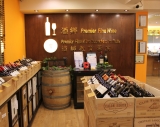John Reynell planted grapes at Reynella in 1838 and later employed a young labourer named Thomas Hardy. In so doing, the foundations were being put in place for two wine dynasties that were to dominate the region for over a century. McLaren Vale became the model of the small winery before such enterprises became fashionable in other states, and it remains one of the most richly varied and highly developed areas in Australia, producing intensely flavoured and coloured red wines and similarly powerful whites.
The region is bordered to the north by the city of Adelaide with Adelaide Hills to the east, Sellicks Hill Range to the south and the Gulf of St Vincent to the west. The landscape though ever changing is nonetheless invariably beautiful, with rivers—notably the Onkaparinga and its tributaries—hills, olive groves and forests all co-existing and confirming yet again the need for the all-important correct site selection.
Hitherto it had been difficult to describe the official climate of McLaren Vale, as there was no local weather station and statistical data had to be taken from the Waite Institute, located in a southern suburb of Adelaide some 25 kilometres (15.5 miles) to the north. However, a weather station was opened in nearby Noarlunga in 2000, and temperature readings have been used from that station in the calculation of heat degree days given below.
Due to varying exposure, the cooling influence of the nearby ocean (or conversely, to protection from it) and also to significant changes in altitude as the region merges with the hills, there is substantial mesoclimatic variation throughout McLaren Vale. Summer rainfall is low and irrigation is considered essential. Site selection and the marriage of site to variety are all important; Shiraz, Cabernet Sauvignon, Grenache, Semillon, Sauvignon Blanc and Chardonnay all do very well in the appropriate location. Riesling tends to be subtle and delicate in youth but ages well. Pinot Noir is used mainly for sparkling wine. Many producers are now experimenting with new and re-emerging varieties including Viognier, Sangiovese, Zinfandel and Verdelho.
There is a wide variety of soil types, a reflection of the varied terrain; red brown sandy loams, grey brown loamy sands with yellow clay subsoils interspersed with lime, distinctly sandy soils (around Blewitt Springs) and patches of red or black friable loams are all to be found. As the long-standing and intensive viticulture attests, most soils in the region are well suited to grape growing.
Info: Australian Wine & Brandy Corporation www.wineaustralia.com












